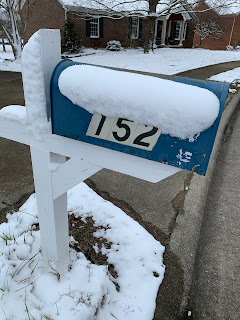I read Ralph Fletcher's latest book,
Focus Lessons: How Photography Enhances the Teaching of Writing during our recent lockdown period.
(There's a brief review at this link.) Because I wasn't teaching in my classroom at the time, but doing what we were calling "Distance Learning" (shudder), I wasn't able to try out Fletcher's suggestions immediately, but they have been percolating in my mind and I've been carrying his book around in my book bag. The other day I tried my first lesson directly influenced by it. Here's a little on how it went.
Although we're back doing traditional school (Hallelujah!), we are trying to keep using Google Classroom regularly. The reasons for this are multiple. One, it's good for students to get used to having a digital component to their classes because that's what they are likely to encounter in future education. Two, you never know when we might need to do distance learning again, and if students are in the habit of using Google Classroom, the adjustment will be less difficult; teachers who were already using it were the ones who had the easiest time making the shift before. Three, it's just always good to have assignments and information posted in several different places, especially when middle schoolers are the target audience; saying something a hundred times is the norm, and each time, someone in the room will be hearing the announcement for the first time.
I recognize the reasons for this, and am fully on board, but it's not second nature to me to use Google Classroom. I have to remind myself constantly to post material there. I'm loving having all of us present in the actual, physical classroom. But I wanted to teach a lesson on writing from photos, and this seemed a good way to handle it. So I asked my students to upload a photo from their own phones, or, if they preferred, from somewhere online.
Most of our students have phones, and it seems to me that we have a constant struggle between claiming we are trying to teach them to use technology, and fighting to get them not to use technology. I recognize how distracting phones can be, but at the same time, when you have in your pocket so many powerful tools, it's a shame not to use them at all. Fletcher thinks similarly. He says: "When we observe a boy taking pictures, we may tend to think:
He's fooling around with his cell phone. What if we thought instead:
He's composing. He's constructing an argument, thinking hard about how best to persuade his viewers. He's creating a story."
Asking the students to upload the photo, rather than just bring it with them to class, either in a paper copy or on their phones, had the advantage of making them think about it ahead of time. They wouldn't just be picking something at random in class. Also, I had access to all the photos to show the day we did the exercise (I warned the kids ahead of time to pick a photo they wouldn't mind classmates seeing).
On the day we did the exercise in class, I put one of my own photos up on the screen. I told the students when I had taken it, talked about the circumstances, and shared with them that I was using it as inspiration for a poem I was writing for a friend's birthday. Then I scrolled through some of the photos the kids had uploaded. People were getting fired up to write. I set the timer for ten minutes, and we all wrote about our photos. I asked them to do theirs in their notebooks, for me to find later to give them credit, but I also said that these might become drafts they'd like to turn in for feedback.
When the timer rang, I showed my students my writing. I didn't read it to them; it wasn't ready for anybody to read. Instead I just held it up, so they could see that it was mostly notes, individual lines, with a lot of crossing out. It wasn't even a first draft, I told them, more notes leading to a first draft. "Brainstorming," one kid called out, and I agreed that was a good word for it.
After this very low-key lesson, we moved into one of our regular writing times. But for the next few days, I saw how fruitful this had been. I had many drafts turned in, some haiku capturing a moment, other longer pieces delving into thoughts the photo had brought up. And after a lot more work, the poem I had been writing ended up in a form that somewhat satisfied me.
Fletcher's book recommends not pushing this. "Demonstrate? Definitely. Assign? Sparingly. By their very nature, assignments limit choice....When it comes to writing from photographs, why not find out what students are already doing in this regard, go with their energy, and see if we might redirect their flow?" I saw this exercise as more of an opportunity to show them that using their photos was an option (I had said it before, but this gave them a chance to try it out). Instead of putting a photo in front of them and having everyone write about the same one (though I have done that in the past, and it's not a bad thing to do), they got to pick the image. And I let them choose what they did with it. If they wanted to keep it in their notebook and never look at it again, that was fine. If they wanted to turn it in, that also was up to them.
I will definitely do this again, and I will also be using Fletcher's book in many other ways. I highly recommend it to writing teachers.























